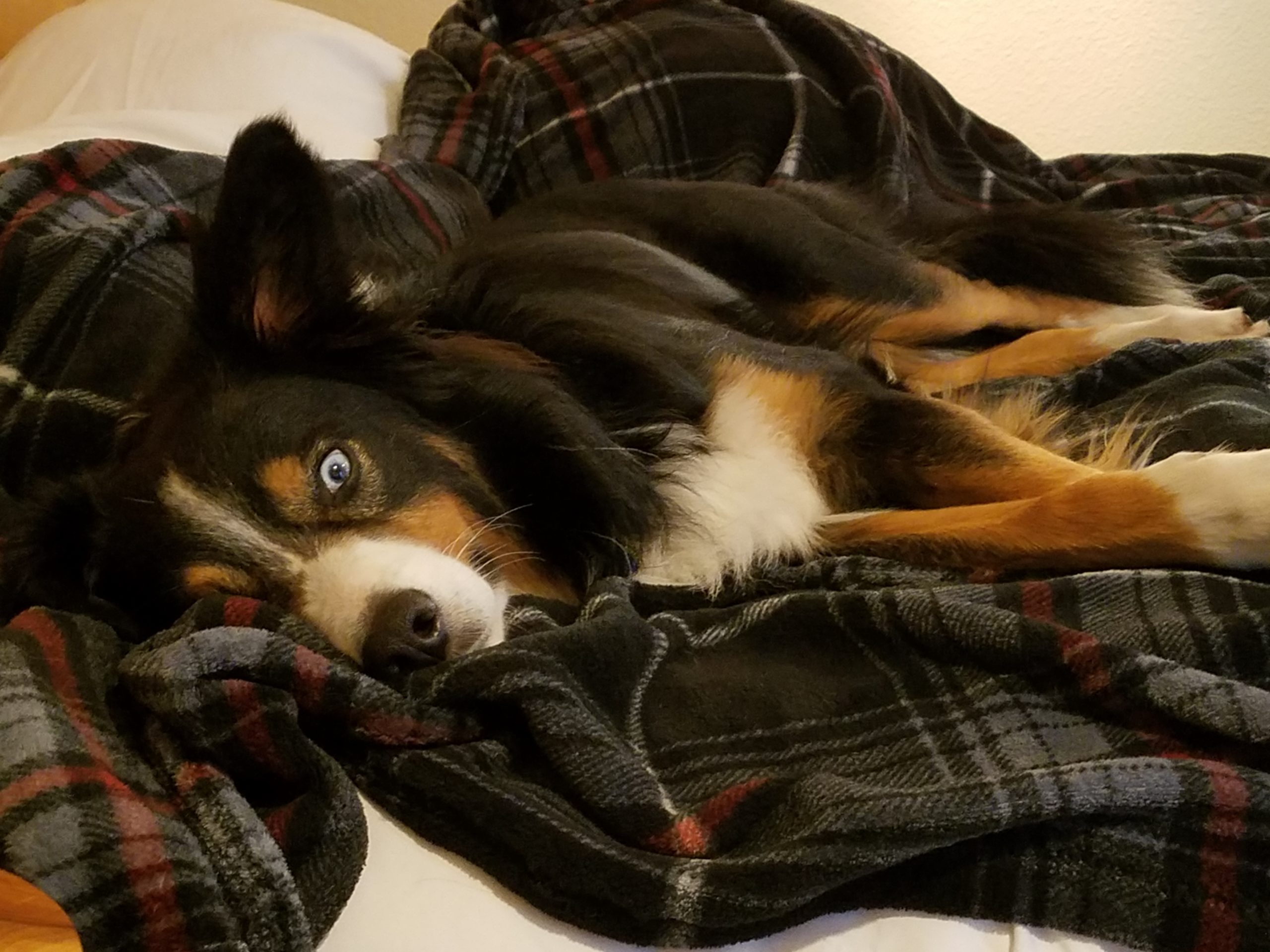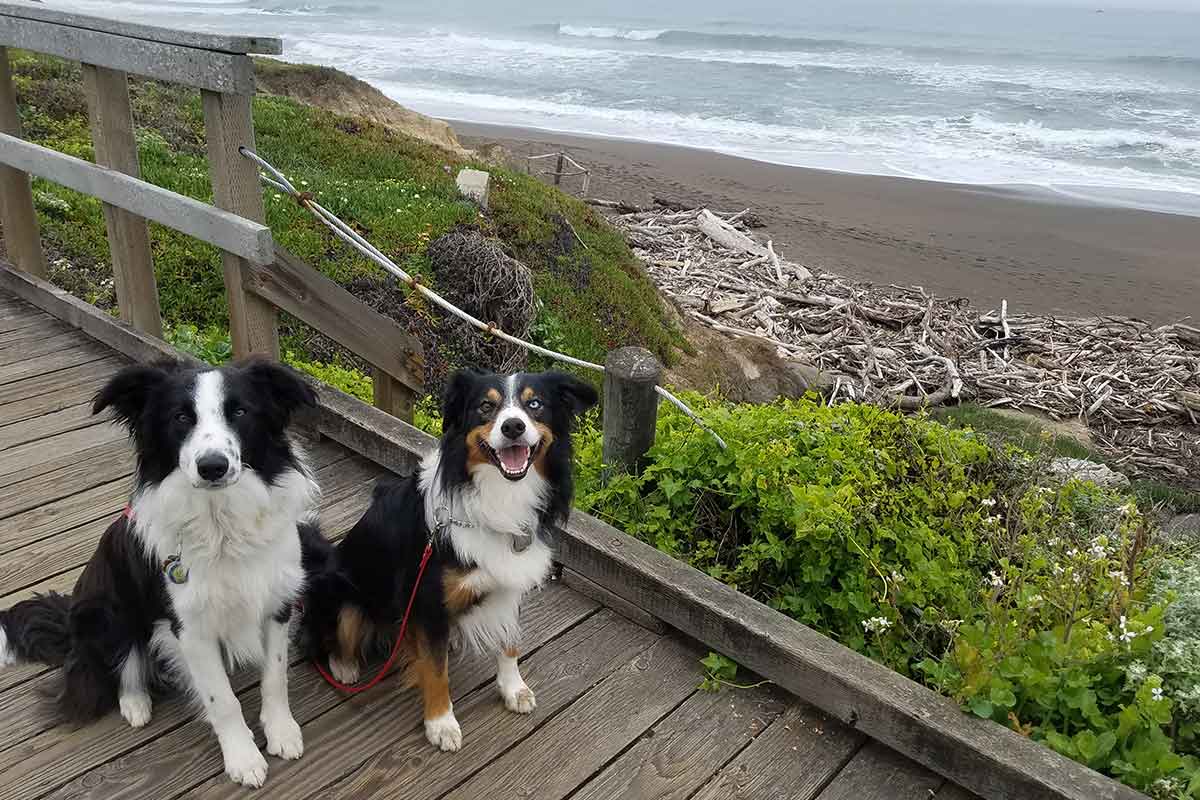Last week I picked up my RV, Astrid (yes, I named my RV!) from the storage spot and brought her home. Once the dogs realized she was home, they sat at the front door nicely, with only smiling faces and wildly wagging tails betraying their excitement. They’re experienced road dogs; Bones, five years old, has more than 23,000 miles of RV travel and Hero, at a year and a half, has more than 6,000 miles.
Once introduced, all of my dogs have loved traveling this way. To keep RVing dogs happy and safe takes a bit of thought and planning, though.
Where Will Your Dog Ride?
My dogs ride in crates anchored to the seat belts for bench seats at the dining room table. This keeps them safe while the RV is in motion. And since they are comfortable in their crates and ride in crates in my car as well, it’s a familiar way to travel.
Some dog owners prefer to use harnesses with straps that fasten to seat belts. These are fine, too, but with my particular RV and dogs, I felt they would be more comfortable in their crates. In any case, make sure your dogs are secure. Just as in a car, they shouldn’t be riding loose. It’s too dangerous.
The Right Dog Stuff
When deciding what to bring, consider your normal routine with your dog. What do you need to maintain that routine? What provides comfort, security, and happiness for your dog? Here are the basics.
Crate and bedding come first, followed by food and water bowls; dog food and medication; toys and grooming supplies; and extra towels for rainy days or trips to the beach. Stow extra leashes and extra collars with identification tags. Don’t forget chew treats and toys for times when he’s bored.
Stop Often On The Road
RVs can cover a lot of miles rather quickly, but don’t forget to keep your dog’s comfort in mind. Too many hours with too few stops will be stressful.
I generally stop every half tank of gas. People and dogs can then relieve themselves, stretch their legs, and your dog can sniff this new place. Dogs love to sniff, and this activity can help them to relax.
When you stop, keep your dog on leash. No matter how well trained, he’s in a new place with strange smells, and at a rest stop there may be large, noisy semi trucks pulling in and out.
A nice walk is good for both people and dogs. Even a walk two or three times around the rest stop (or shopping center or truck stop) is great. Your dog can relieve himself, too, (clean up after him, please) as well as get some exercise.
Once you’re back in the RV after your walk, offer your dog some water and a treat or two, and let him walk around the RV as you relieve yourself and get a snack. Before you hit the road again, put him back in his crate. After a few stops your dog will learn this new routine.

Stopping For The Night
Once you stop at your campground, RV park, or beach for a night’s stay, the inclination is to get the RV all set up. People generally want to get it level, plug in the electricity and hook up the sewer hose. Wait a few minutes for that, though, and take your dog out for a walk. Granted, you’ve been driving and are probably tired, but he’s most likely bored. Once you’ve both had a good walk, then set up the RV.
I carry exercise pens in an underneath storage area. I set these up on the side of the RV where the door is so that they are under the awning. I can then set up a lawn chair there and relax while my dogs investigate the smells, watch the scenery, and otherwise get used to this new place. I never leave my dogs out there without me, however, as these foldable fences aren’t that secure.
At bedtime, I invite my dogs into my bed. This serves several purposes; first; my dogs have been in the crate while we’ve been driving so this gives them time outside the crate. Also, they can warn me if something is not right during the night. Lastly, if one of my dogs is feeling a bit anxious or worried, sleeping with me provides reassurance.
Daily Routine
When you’ve reached your destination or have stopped someplace for a day or two, your dog may feel unsettled. He may know the travel routine while you’re driving, but the daily routine while you’re stopped may be harder for him to cope with.
Taking walks will help, of course, but he also needs to learn to relax. If he’s had some obedience training, ask him to lie down and stay now and then. He can do that on his bed, on the table’s seating bench, or any other place close to you. Offer him one of his chew toys. Help him understand that he can relax here just as he does at home.
Routine Provides Security
Even when traveling I try to maintain a regular routine for my dogs. A routine for stopping, walking, potty breaks, water, snacks, meals, play time, and sleeping will ensure that your dog knows those important things will happen when they should. He can cope with many changes when you’re by his side and all the important things happen when they should.
This article was reviewed/edited by board-certified veterinary behaviorist Dr. Kenneth Martin and/or veterinary technician specialist in behavior Debbie Martin, LVT.








